Cymbidium orchids, known for their striking beauty and long-lasting flowers, boast over 50 species and thousands of hybrids, offering an extensive palette of colors, shapes, and sizes. They are highly prized for their elegant blooms which can last up to ten weeks, making them a favorite among orchid enthusiasts and floral arrangers alike.
Quick Facts
| Characteristic | Detail |
|---|---|
| Countries of Origin | Asia (especially India, China, Japan) and Australia |
| Colors | Wide range including green, white, yellow, pink, and red, often with contrasting markings |
| Size | Large; plants can grow to be quite tall with long, strappy leaves |
| Difficulty To Grow | Moderate; requires specific care, especially regarding temperature changes |
| Bloom Season | Late fall to early spring |
| Light Requirements | Bright, indirect light; tolerates lower light levels than many other orchids |
| Watering Needs | Consistent moisture during growth period, reduced in winter |
| Temperature Range | Prefers cooler temperatures, especially at night to initiate blooming |
| Potting Medium | Well-draining mix, often a combination of bark, perlite, and moss |
| Propagation Methods | Division, back bulbs, sometimes seed in specialized conditions |
| Common Pests and Diseases | Mealybugs, scale insects, and virus transmission are concerns |
| Fragrance | Some species and hybrids are fragrant, especially during the day |
| Lifespan/Longevity | Long-lived, with proper care plants can last decades; individual blooms last several weeks |
| Conservation Status | Not generally endangered, but habitat loss affects wild populations |
| Unique Features | Noted for their large, showy flowers and ability to withstand cooler temperatures than most tropical orchids |
As a garden enthusiast and writer deeply invested in the cultivation of ornamental plants, I have a profound admiration for the captivating beauty of Cymbidium orchids.
These floral gems, hailing from the Orchidaceae family, are distinguished not only by their entrancing boat-shaped lips but also by their remarkable range of species.
My personal experiences with the care and enjoyment of these orchids have led me to recognize their considerable resilience, adaptability, and the sheer diversity of cymbidium orchid varieties available to collectors and gardeners alike.
Their allure extends beyond visual delight; intricate symbolism and historical reverence have made Cymbidiums cherished across the globe.
As an aficionado, I’ve learned that orchid care is a fundamental aspect that contributes to the enduring vibrancy and longevity of their blooms, something that resonates with enthusiasts worldwide.
Key Takeaways
- A deep understanding of Cymbidium orchids enhances their cultivation and enjoyment.
- Awareness of the varieties ensures informed selection for personal gardens.
- Proper orchid care routines are crucial for the health and vitality of Cymbidiums.
- Appreciation of the species’ history and symbolism enriches the gardening experience.
- Sharing insights on Cymbidium orchids can guide fellow enthusiasts toward successful cultivation.
Discovering Cymbidium Orchids: A Floral Treasure
As a passionate horticulturist, I find that Cymbidium orchids represent a fascinating world of botanic diversity and color. Tracing their lineage and distribution offers a glimpse into how they have spread from the lush foothills of the Himalayas to the temperate regions of Australia.
This journey not only highlights their adaptability but also underlines the importance of orchid cultivation in preserving these botanical gems. So let’s delve deeper into the origins, defining characteristics, and species diversity of this remarkable genus.
Origins and Distribution: Asia, Australia, and Beyond
The story of Cymbidium orchids begins in the vast landscapes of Asia, where many orchid species first captivated the eyes of early botanists with their intricate blooms.
From the rugged terrains of the Himalayas to the humid climes of Southeast Asia and the varied Australian environments, Cymbidiums have carved out their ecological niches, manifesting the true breadth of the orchid family’s adaptive prowess.
Defining Characteristics: From Boat-Shaped Lips to Evergreen Leaves
The Greek term “kumbos,” meaning boat, lends its name to these orchids, paying homage to the delicate, boat-shaped lips that define the Cymbidium’s flowers.
Their evergreen leaves present yet another significant trait, offering a year-round display of verdant foliage. This resilience is what entices many enthusiasts, myself included, to engage deeply with orchid cultivation.
Species Diversity: Exploring the Disparate Members of the Cymbidium Genus
Within the genus Cymbidium, there is a mosaic of species, each with its own unique set of characteristics and requirements. This diversity is a clear indication of the evolutionary success of this group.
Whether growing as an epiphyte, clinging to trees or as a lithophyte, gripping onto rocks, these orchids often grow with robust pseudobulbs. Each pseudobulb is capable of producing a splendid flower spike, with leaves that can thrive for years, contributing to a lush and expansive plant over time.
Thus, the Cymbidium orchid colors that adorn our homes and gardens each season are as varied as the species themselves.
Below is a table showcasing the incredible variety of colors found in Cymbidium orchids, reflecting the richness of their palette:
| Color Category | Examples of Cymbidium Orchid Colors |
|---|---|
| Whites and Creams | Alba, Ivory, Snowcap |
| Pinks and Reds | Rosy Sunset, Scarlet Flame, Blushing Maiden |
| Yellows and Oranges | Golden Glow, Citrus Delight, Saffron Spark |
| Greens and Browns | Emerald Whisper, Hazel Whisper, Mossy Meadow |
| Spotted and Patterned | Leopard Spots, Tiger Stripe, Stippled Star |
The allure of Cymbidium orchids is undeniable, with their reputation for longevity and robustness making them popular both as cut flowers and as thriving potted plants.
It’s a privilege to witness how the careful cultivation of these species contributes to the ever-expanding kaleidoscope of orchid diversity that brightens our world.
The Cultural Essence of Cymbidium Orchids
Entwined with rich cultural threads, the Cymbidium orchid stands as a symbol of much more than mere botanical beauty. The profound symbolism and cultural significance of these flowers span continents, connecting with human emotions and social customs.
In my exploration of their role beyond horticultural splendor, I have discovered compelling narratives that encapsulate the essence of these vibrant blooms.
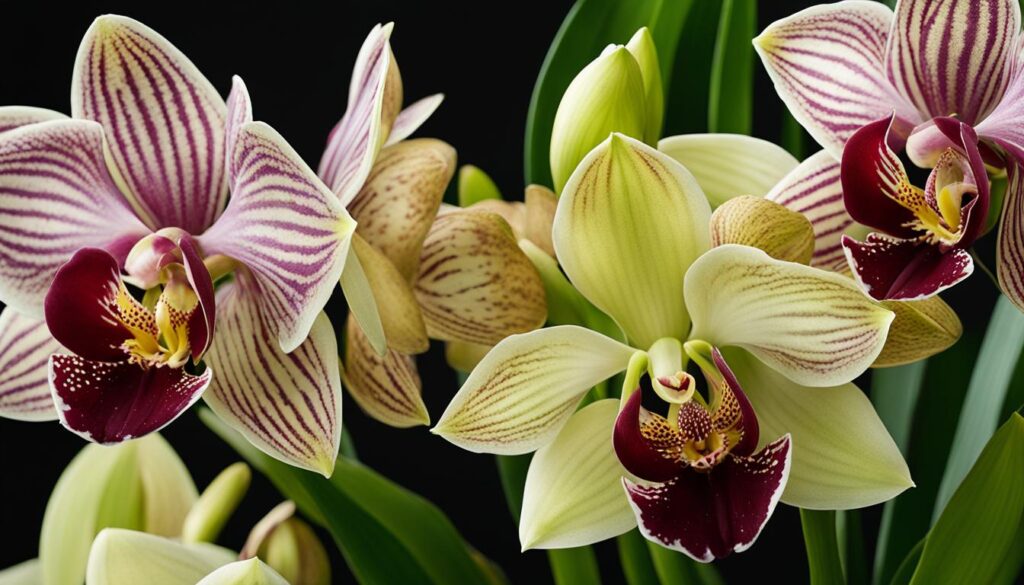
Symbolism in Different Societies: More Than Just a Beautiful Flower
Throughout the ages, the Cymbidium orchid has been revered, epitomizing love, beauty, and luxury. In Asian traditions, where their cultivation is woven into the fabric of history, they often represent prosperity and good fortune.
Let’s not forget their pivotal role in symbolizing cherished values such as friendship and respect, embodying the ethics of social harmony and kindness.
Orchids in Art and Mythology: The Intriguing Role of Cymbidiums
The cultural fingerprints of Cymbidium orchids are also distinct in the realms of art and mythology. As muses to artists and storytellers, they have been painted, sculpted, and celebrated in numerous forms.
They have come to be associated with purity, serenity, and the gracefulness of a hermit, infusing moral and ethical symbolism into their representation.
| Cultural Significance | Symbolism Meanings | Associated Values |
|---|---|---|
| Asian Traditions | Prosperity, Good Fortune | Wealth, Success |
| Artistic Representation | Purity, Serenity | Morality, Peacefulness |
| Modern Ceremonies | Love, Respect | Friendship, Admiration |
As a passionate gardener and scholar of cymbidium orchid care, understanding the depth of their cultural resonance enhances my appreciation for their presence in both my greenhouse and living spaces.
It’s a privilege to cultivate a plant that carries such profound symbolism and meaning across the globe.
Cymbidium Orchid Varieties and Their Captivating Colors
I’m always entranced by the robust diversity of cymbidium orchid varieties and the captivating colors that they showcase. These colors do far more than just please the eye; they’re a testament to the adaptability and vast color palette these plants have developed through both natural selection and careful hybridization by enthusiasts and experts alike.
From Soft Whites to Striking Greens: The Palette of Cymbidium Blooms
The color range of cymbidium orchid blooms is simply astounding. Delicate soft whites evoke a sense of purity and peace, while the vibrant greens and yellow greens burst forth with life and vitality.
The pastel tones of cream and pink add a soft, sophisticated touch to any collection. It’s no wonder that the cymbidium orchid colors are often used to set the mood in floral arrangements and garden design.
Understanding Color Patterns: The Art of Cymbidium Hybridization
Enthusiasts of hybridization understand the true artistry behind creating new cymbidium orchid varieties. This process combines the genetic material of different parent plants to produce offspring with unique and often spectacular color patterns.
These hybrids can bring forth new shades, striking color combinations, and patterns that might never occur in nature, expanding the spectrum of cymbidium orchid colors ever further.

| Color Category | Description | Seasonality |
|---|---|---|
| Soft White | Classic elegance, symbolizing purity and grace | Winter-Spring |
| Vibrant Green | A refreshing and unique hue, evoking energy and renewal | Spring |
| Yellow-Green | Cheerful and bright, perfect for springtime display | Spring-Summer |
| Cream | Warm and inviting, adding a peaceful touch to arrangements | Autumn-Winter |
| Pink | Romantic and delicate, popular in celebratory bouquets | Winter-Spring |
To sum up, what I find most inspiring about cymbidium orchid varieties is not just their beauty but their ability to enhance our living spaces with their diverse colors.
Every variety brings with it a distinct personality, and understanding them can profoundly impact your floral design choices and gardening approach. Whether in bloom during the subdued light of winter or the vibrant sunshine of spring, these colors craft a narrative in flora that continues to captivate and charm.
Cymbidium Orchids: Care and Cultivation Tips
Thriving in a devoted gardener’s care, Cymbidium orchids embody the grace of the orchid family. My passionate affinity for horticulture illuminates the path to cultivating these magnificent blooms.
Here, I’ll guide you through achieving the quintessential conditions for your Cymbidium orchid’s prosperity.
Meeting Light Requirements for Vibrant Blooms
cymbidium orchid light requirements must be met to inspire the full spectacle of their flowering prowess. Bright, diffused sunlight coaxes out the richest colors of the blooms, affirming its place as essential to orchid care.
Their preference is towards eastern or southern exposure, fostering a luminary dance with the morning sun.
Watering Routines: Balancing Moisture for Optimal Growth
The art of cymbidium orchid watering lies in the balance. It’s crucial to quench their thirst whilst avoiding saturating their roots. Allow the potting medium’s upper layer to become somewhat dry, feeling just damp to the touch, before the next watering.
This method prevents the risk of root rot, elevating your plant’s health and longevity.
Temperature and Feeding: Creating the Perfect Environment
Temperature swings notably embolden Cymbidiums to showcase their floral array. Cooler nights, particularly in the seasonal shift to autumn, prompt their blooming cycle.
Amidst these temperatures, regular feeding with a proper balance of nitrogen, phosphorus, and potassium, is my advised approach to sustain their vigorous flowering.
| Aspect | Details | Benefits |
|---|---|---|
| Light | Bright, indirect sunlight | Promotes blooming and vibrant colors |
| Watering | Top inch of potting medium dry between waterings | Ensures adequate moisture without overwatering |
| Temperature | Cooler evenings with a fluctuation of 10-15°F (5-8°C) | Initiates and maintains blooming cycle |
| Feeding | Regular intervals with balanced orchid fertilizer | Supports lush growth and abundant flowering |
In the heart of my horticultural endeavors, I find joy in sharing the nurturing whisper that orchids reciprocate with blooming gratitude. Let’s shepherd these celestial blooms with adept care, for they are a testament to our guardianship over nature’s marvels.

The Resilient Nature of Cymbidium Orchids
As a devotee of orchid care, I’ve found Cymbidium orchids to be strong and hardy, easily rising to the challenge of various environmental conditions. Their ability to flourish in both hot, humid tropics and cooler, alpine regions exemplifies their adaptability and resilience.
This robustness has not only made them popular among gardeners but also contributed to their status as a protected species in some areas, highlighting the importance of preserving their biodiversity.
Adaptable to Various Climates: A Testament to Hardy Orchid Species
The remarkable adaptability of Cymbidium orchids is unparalleled. My experience cultivating them has shown that whether nestled in a temperate shade garden or basking in subtropical warmth, these orchids persevere.
The secret lies in their rigorous genetic makeup which enables a versatility that’s been perfected by nature to withstand various climates, affirming the ‘strong and hardy’ description they’re often given.
To aspiring cultivators, this genetic fortitude translates to less worry over the perfect growing conditions, allowing more focus on the beauties of the blooms.
Tackling Common Pests and Diseases: Maintaining Healthy Orchids
No garden is without its challenges, and even these rugged beauties require vigilance to maintain their health. Pests like aphids and scale insects, or the dreaded spider mite, can stress even the most robust specimens.
Diseases such as root rot and the Cymbidium Mosaic Virus also pose threats to their well-being. Nonetheless, with consistent and informed orchid care, these obstacles can be overcome, reinforcing the orchids’ status as a flourishing and preserved treasure among plant species.
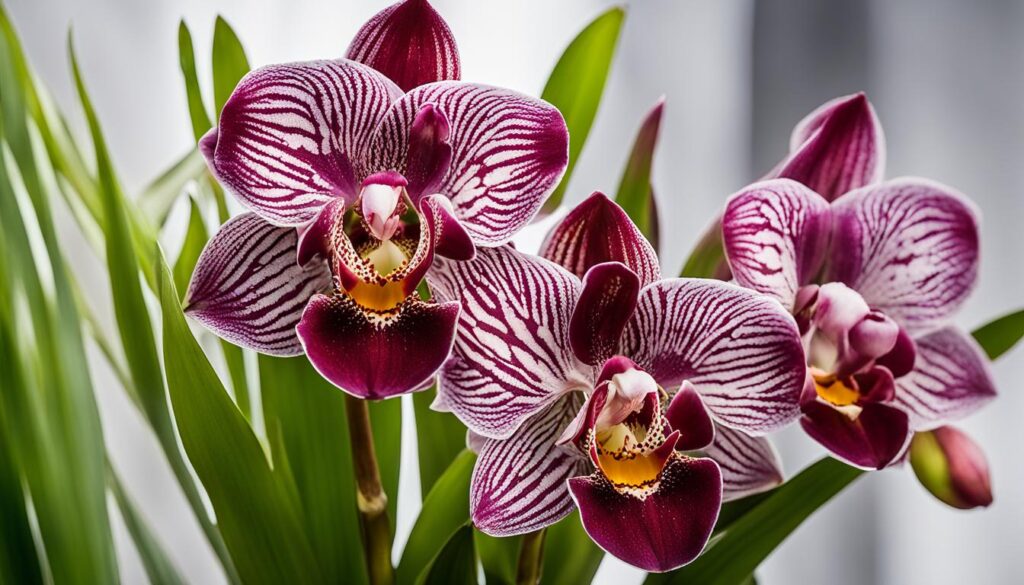
Cymbidium Orchid Propagation: A Gardener’s Guide
As a devoted gardener, I find that expanding the beauty of my orchid collection through orchid cultivation is a rewarding venture. Specifically, the cymbidium orchid propagation commands attention for its straightforward and rewarding nature.
With two main methods at our disposal, division, and hybridization, both seasoned and novice gardeners can experience the satisfaction of propagating these magnificent plants.
Division: Spreading Beauty by Careful Separation
Division is the process by which a single Cymbidium Orchid is gently separated into multiple plants. This horticultural technique relies on the division of pseudobulbs, the swollen storage organs of the orchid from which new shoots and blooms will emerge.
This method preserves the genetic identity of the plant, ensuring that each new orchid is a replica of its parent.
- Wait until the orchid has finished blooming before attempting division.
- Remove the plant from its container, shaking off excess potting material.
- Identify healthy pseudobulbs with at least three to four bulbous growths.
- Use a clean, sharp knife to separate these sections, ensuring each division has a root system attached.
- Plant each division in its new pot with a suitable orchid potting mix.
While dividing your Cymbidium Orchids, sanitation is key. My advice is to always use sterilized tools and pots to avoid spreading disease among your treasured plants.
Creating New Hybrids: The Science and Art Behind Orchid Breeding
For those yearning to push the boundaries of orchid beauty, creating new hybrids through cross-pollination is a fascinating endeavor. This delicate process allows us to merge the strengths of two different orchid varieties, potentially cultivating novel blooms that are as robust as they are enchanting.
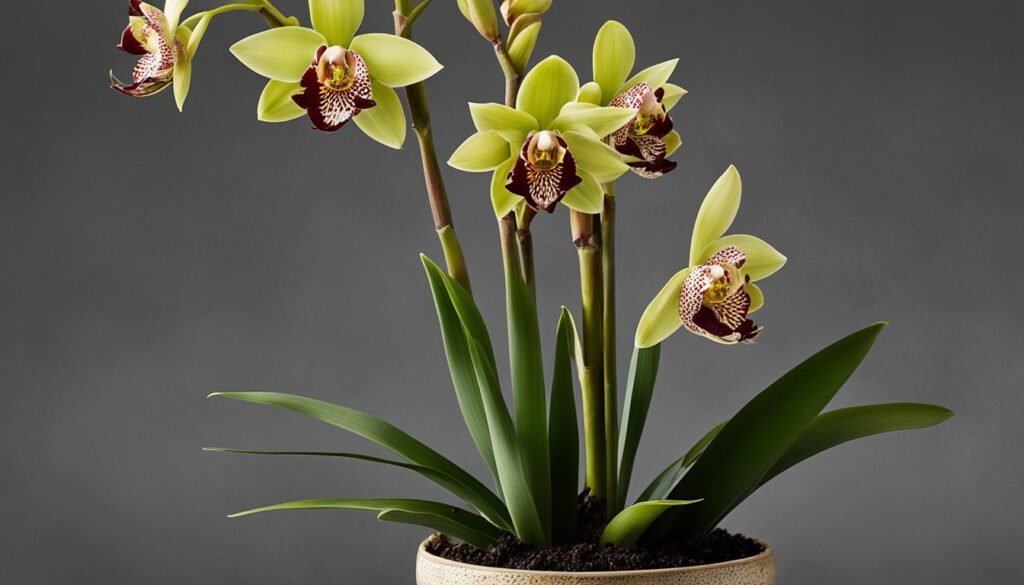
As an example, to create a new Cymbidium hybrid, I follow these steps:
- Select two flower varieties that possess the desired traits.
- Use a fine brush or a similar tool to transfer pollen from the donor flower to the stigma of the recipient.
- Label the cross to keep track of the parentage.
- After successful fertilization and seed pod formation, seeds require sowing in a sterile environment, like an agar-based growth medium in a flask.
- Patience is a virtue as it can take several years for seedlings to mature and flower.
The adventure of breeding new Cymbidium hybrids is filled with anticipation and occasional surprises. It bridges the gap between horticulture and art, producing exquisite results that I treasure in my garden.
| Propagation Method | Primary Benefit | Difficulty Level |
|---|---|---|
| Division | Genetic consistency of the orchids | Beginner-friendly |
| Hybridization | Creation of new and unique varieties | Advanced |
In conclusion, the propagation of Cymbidium Orchids through division and hybridization offers a fulfilling path for gardeners. It nurtures a deep connection with the natural world, as we aid in the creation and spread of floral beauty.
Embrace the method that suits your gardening style, and witness the remarkable proliferation of these stunning blooms.
Celebrating Cymbidium Orchids in Social and Ceremonial Events
As a passionate cultivator and admirer of the Cymbidium orchid, I have witnessed the pronounced cultural significance of these magnificent blooms.
Not only do they transform any space with a touch of sophistication, but they are also a veritable fountain of medicinal properties that have been cherished for centuries.
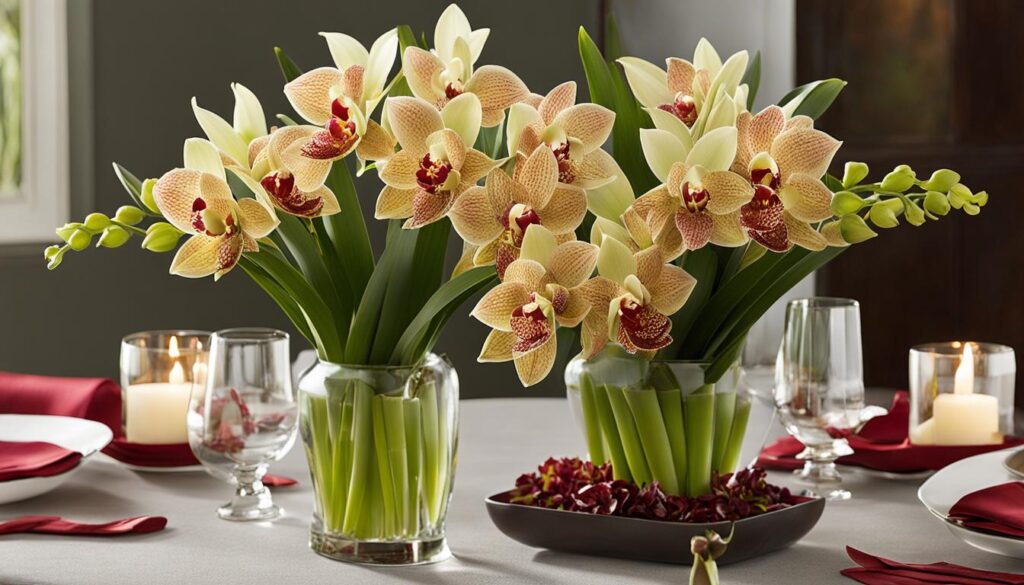
Weddings and Festivals: Embracing Orchid Elegance
Nothing says elegance at a wedding like the presence of cymbidium orchids. Their resilience ensures they stay pristine throughout the event, making them a reliable and exquisite choice for bridal bouquets, centerpieces, and venue decor.
Festivals too are enriched by the lush colors and graceful presence of Cymbidiums, symbolizing luxury and grace at every glance. It’s no wonder that these orchids have become synonymous with life’s most celebrated moments.
Medicinal Uses: The Lesser-Known Benefits of Cymbidiums
It’s fascinating how the Cymbidium orchid provides more than just visual splendor. Rooted deeply in traditional Chinese medicine, Cymbidiums have been used to treat various ailments, especially those related to the respiratory and digestive systems.
My journey with these orchids transcends their beauty, as I delve into their medicinal properties, reaffirming their invaluable role across cultures and health disciplines.
To explore more about how to care for and maintain these versatile and historically rich flowers, a robust cymbidium orchid care guide can be an indispensable resource for enthusiasts and professionals alike.
Conclusion
As I have journeyed through the captivating world of Cymbidium orchids, it is evident that these botanical treasures provide an embodiment of both natural beauty and historical significance.
The exploration of various Cymbidium orchid varieties has revealed a vibrant blend of colors and shapes, while an understanding of orchid care highlights the balance of art and science necessary to foster these enchanting blooms.
United by a shared passion for horticulture, gardeners and orchid enthusiasts alike find common ground in the diverse range of Cymbidiums available.
Infusing Elegance into Your Garden with Cymbidium Orchids
Integrating Cymbidium orchids into your garden or home not only introduces a flourish of elegance but also an air of sophistication. As living art, these orchids capture the essence of refinement with their striking presence.
The key to their care lies in understanding their need for indirect light, regular hydration, and cool temperatures—conditions that allow them to thrive and showcase their magnificent blooms.
A Journey Through the Richness of Cymbidium Varietals
The richness of Cymbidium orchid varieties is as vast as it is captivating. From the classic beauty of pure whites to the exotic charm of striking greens and yellows, the Cymbidium palette is a testament to the species’ adaptability and hybridizers’ ingenuity.
By embarking on the fascinating pursuit of cultivating these splendid orchids, I have gained an appreciation for the subtleties of their care, the depth of their history, and their cultural significance which spans continents and centuries.
Truly, Cymbidium orchids invite us into a world where the rewards of patience and attentive care are abundant and the splendor of nature is displayed in full array.
FAQ
What are Cymbidium Orchids?
Cymbidium Orchids, also known as boat orchids, are part of the Orchidaceae family. They have about 60 species and are known for their distinctive boat-shaped lips and long-lasting, colorful flowers. These orchids are native to Asia and Australia, but they have been cultivated across the world due to their beauty and resilience.
How do I care for my Cymbidium Orchid?
Orchid care for Cymbidiums involves providing bright, indirect light, watering the plant when the top inch of potting mix is dry, and feeding with a balanced orchid fertilizer during the growing season. They prefer cooler temperatures, particularly at night, which can trigger blooming.
What are the different varieties of Cymbidium Orchids?
Cymbidium Orchid varieties range in color from whites and greens to pinks, creams, and various patterned hybrids. Orchid cultivators continue to create new hybrids, further expanding the variety of colors and patterns available. Each varietal has its unique characteristics that add to the richness of this species.
What climate is best for Cymbidium Orchids?
Cymbidium Orchids are resilient and adaptable to different climatic conditions. They can thrive in both hot and humid regions as well as cooler mountainous areas. However, they generally prefer a cooler climate, which can encourage the plants to produce their characteristic blooms.
What are the common pests and diseases that affect Cymbidium Orchids?
Common pests that can affect Cymbidium Orchids include aphids, scale, and spider mites. Diseases such as root rot and Cymbidium Mosaic Virus can also pose a threat. Good orchid care practices, such as proper watering and maintaining clean growing conditions, can help keep these issues at bay.
How can I propagate my Cymbidium Orchid?
Propagation of Cymbidium Orchids is commonly done by division of the plant’s pseudobulbs, ideally during repotting when the plant becomes overcrowded. This will create an exact clone of the parent plant. Breeding new hybrids through cross-pollination can also produce unique offsprings with varying traits.
What are the cultural significances of Cymbidium Orchids?
Cymbidium Orchids carry deep cultural significance in many societies, symbolizing love, beauty, luxury, and even luck and prosperity. They are frequently found in art and mythology and are often used in social and ceremonial events like weddings due to their enduring beauty and elegance.
How should I water my Cymbidium Orchid?
Cymbidium Orchids should be watered after allowing the top inch of the potting mix to dry out. Avoid letting the plant sit in water as this can lead to root rot. During the active growth period, watering may be more frequent, while during the winter months, it should be reduced.
What light requirements do Cymbidium Orchids have?
Cymbidium Orchids need bright, indirect light to thrive. Direct sunlight can scorch their leaves, so it’s best to place them in a location where they will receive filtered light. An east or west-facing window is often an ideal spot for these orchids.
Are Cymbidium Orchids used for medicinal purposes?
Yes, Cymbidium Orchids have been used in traditional Chinese medicine for various health benefits, particularly concerning respiratory and digestive issues. However, these medicinal uses are based on traditional knowledge, and it’s important to consult health professionals regarding their use.

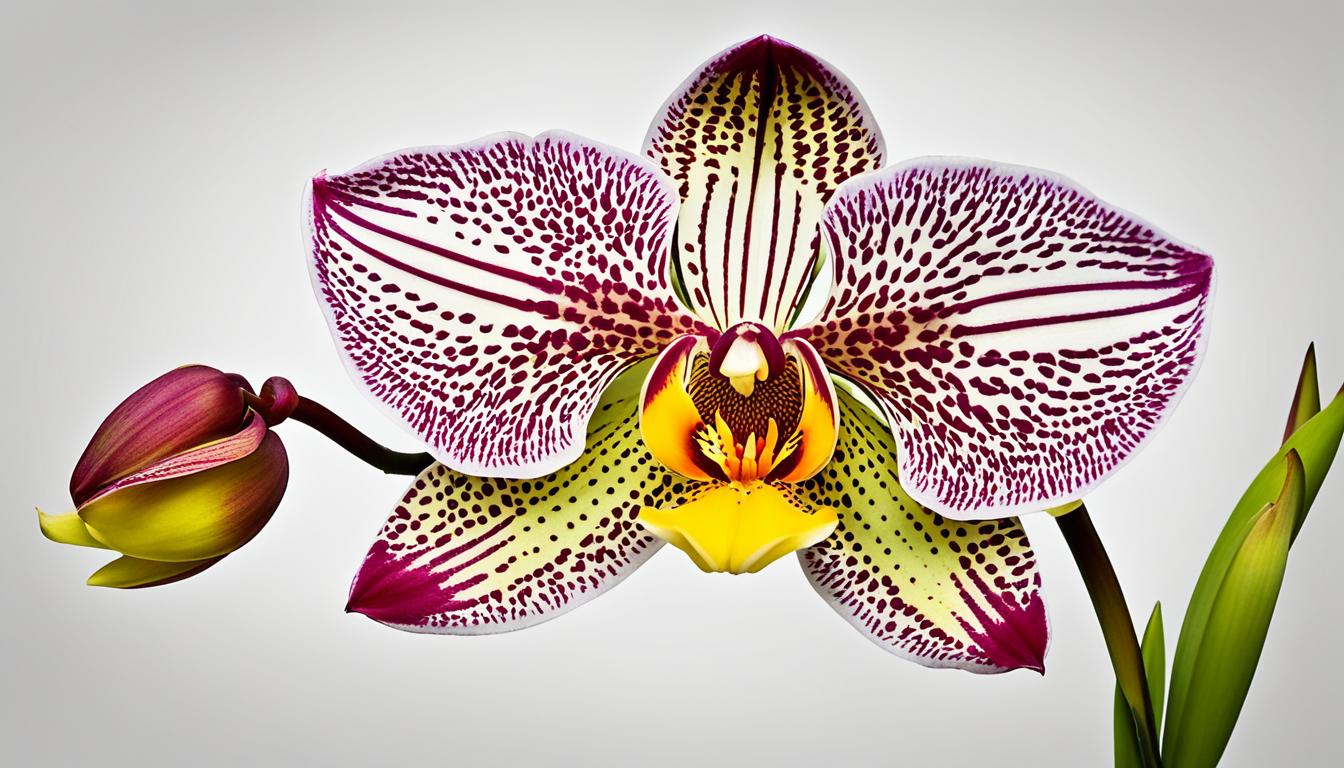
Leave a Reply